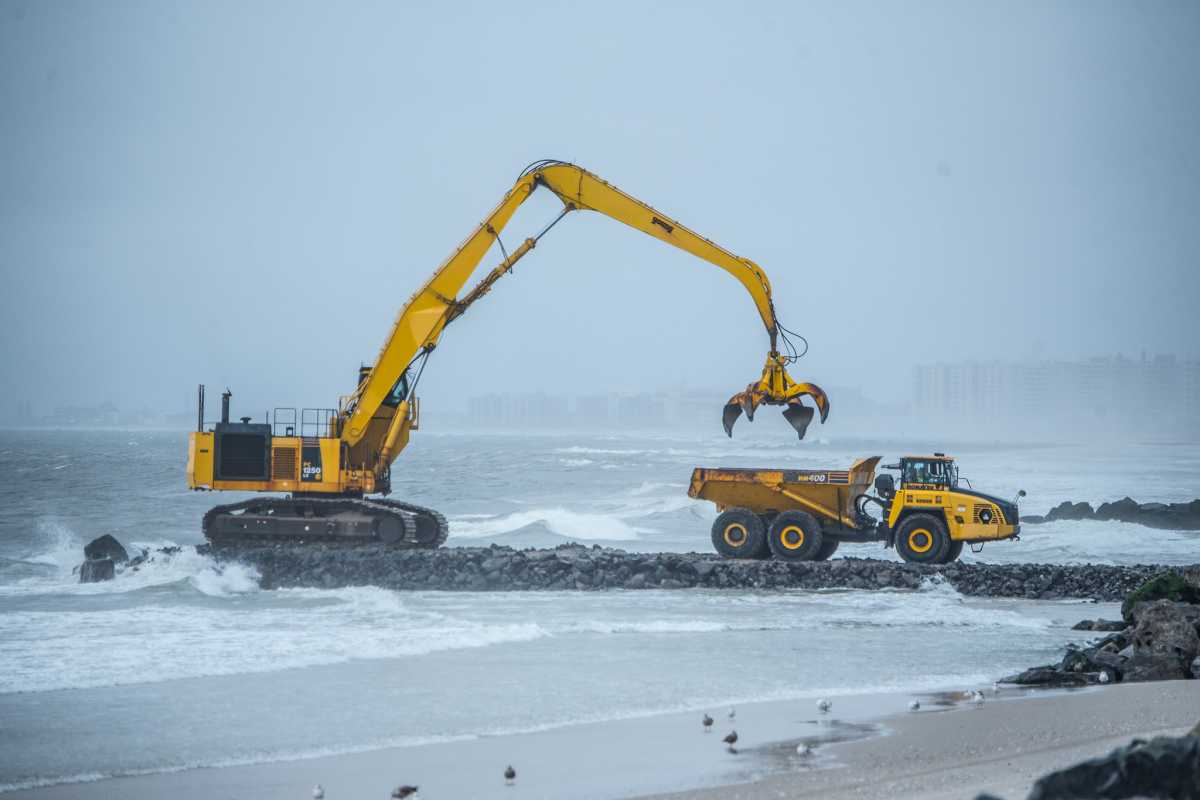Eight years after Superstorm Sandy crashed into the Rockaways, Mayor Bill de Blasio, Governor Andrew Cuomo and the U.S. Army Corps of Engineers announced that construction has begun on the Atlantic Shorefront Project which will protect communities and strengthen the shoreline along a six-mile stretch of the Rockaway Peninsula.
The $336 million infrastructure project consists of a reinforced dune system designed to block storm surge and new and extended tapered groins, jetty-like structures extending out into the ocean intended to trap sand and reduce beach erosion and help maintain a critical buffer between the Atlantic Ocean and beachfront communities.
“Eight years ago, Hurricane Sandy devastated our city and our shoreline,” de Blasio said. “We committed to building back stronger than ever, and I am thankful for federal and state partners for working together to make this critically important project come to life.”
The first phase of construction will include 14 stone groins and the rehabilitation of five existing groins on the Atlantic Ocean side of the Rockaway Peninsula.
“Climate change is already impacting our everyday lives, and the Rockaways are at the forefront of damaging flooding from strong and frequent coastal storms driven by warmer temperatures,” Cuomo said.
The second phase of construction will include a reinforced dune system that will consist of armor stone and steel pile walls at their core, which will reduce wave breaking pressure and limit storm surge inundation and cross-peninsula flooding. All public access points across the dunes will be rebuilt using resilient materials.
“Ever since Hurricane Sandy devastated the Rockaways, I have fought tooth and nail to secure hundreds of millions of dollars to rebuild homes, schools, and playgrounds, as well as construct a new boardwalk, stone groins, and reinforced dunes across the Atlantic shorefront to protect this community from future superstorms,” Senator Charles Schumer said. “With this important project finally underway, the beaches of the Rockaways, from Far Rockaway to Neponsit, will soon match the resilience of the people who live alongside them.”
The design of this project resulted from extensive analysis to determine best practices for a more resilient beach and shoreline as part of the U.S. Army Corps of Engineers’ East Rockaway Inlet to Rockaway Inlet, and Jamaica Bay Study, which was completed and released in 2018.
“I am thrilled to see the Army Corps of Engineers commence their work to reinforce Rockaway’s shoreline, providing a long-term solution for greater resilience to our beach and community,” Congressman Gregory Meeks said. “The reinforced dunes and stone jetties will be instrumental in preventing future storms from eroding our shore, helping our beaches remain open for business.”
Work has begun with the construction of new groins in the Beach 30s. The full Atlantic Shorefront Project is expected to reach completion in four years.
“On the 8th anniversary of Superstorm Sandy, I am thrilled to see the start of construction on this much-needed coastal resiliency project that will help protect our communities from coastal flooding and beach erosion,” state Senator Joseph Addabbo said. “After witnessing the devastation of Sandy, I know we can’t afford to have another superstorm or hurricane inflict massive damage to our communities like Sandy did eight years ago. All the aspects of this project will go a long way in safeguarding the beaches and coastal areas to the effects of climate change.”
When Sandy struck in 2012, more than 1,000 structures were either substantially damaged or destroyed by the storm surge which reached 10 feet.
‘As we reflect on the eighth anniversary of Superstorm Sandy, it is critical that we ensure that short and long-term protections are put in place to protect the Rockaway Peninsula,” Councilman Donovan Richards said. “As climate change continues to disproportionately impact environmental justice communities, it is imperative that capital investment such as the Atlantic Shorefront Resiliency Project move forward.”





































